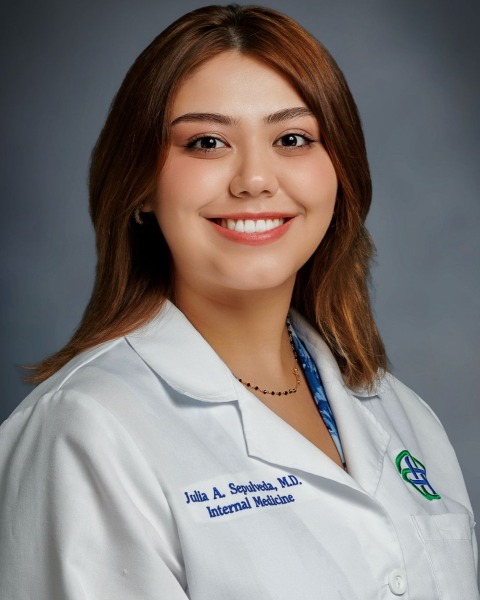Sunday Poster Session
Category: Stomach and Spleen
P2099 - Good for Lungs, Bad for Dinner Plans: Iatrogenic Achalasia and Gastroparesis After VATS
Sunday, October 26, 2025
3:30 PM - 7:00 PM PDT
Location: Exhibit Hall

Julia A. Sepulveda, MD, BS (she/her/hers)
Digestive Health Associates of Texas
Fort Worth, TX
Presenting Author(s)
Julia A. Sepulveda, MD, BS
Digestive Health Associates of Texas, Fort Worth, TX
Introduction: Intraoperative autonomic nervous system injury at the level of the esophageal plexus resulting in severe gastrointestinal dysfunction including achalasia or gastroparesis following VATS is infrequently encountered. This case highlights a rare but serious complication of VATS- iatrogenic vagal nerve injury, underscoring the need for careful intraoperative nerve preservation.
Case Description/
Methods: A 76-year-old Caucasian female was evaluated for sudden onset of dysphagia and persistent emesis immediately following VATS. A subsequent EGD showed new findings of severe esophagitis and constriction at the GE junction, which were not present on EGD eight months prior, raising concern for new onset achalasia. Confirmatory testing with esophageal, manometry and gastric emptying study (GES) were performed which showed Type 1achalasia and substantially delayed gastric emptying respectively. Given the severe debility of the patient’s symptoms, she underwent Heller myotomy with hiatal hernia repair and pyloroplasty without relief of symptoms resulting in placement of G-J tube. Consultation by Foregut Surgery was then pursued, despite interventions in the form of short course PPI, repeat manometry and GES continued to show achalasia and delayed gastric emptying. Revision of the hiatal hernia repair with revision of fundoplication and pyloroplasty with eventual palliative goal of gastric bypass and esophagectomy are currently being pursued.
Discussion: This case illustrates the potentially serious complications of iatrogenic periesophageal vagal nerve injury during VATS and the value of preserving vagal nerve integrity. Although rare, further studies into the preservation and mitigation of intraoperative injury to periesophageal vagus nerve fibers during VATS such as sharp dissection instead of blunt or thermal dissection near the esophageal plexus, preventing excessive traction or cautery and intraoperative nerve monitoring using EMG electrodes are critical to improving the quality of life in patients undergoing this procedure.
Disclosures:
Julia Sepulveda indicated no relevant financial relationships.
Julia A. Sepulveda, MD, BS. P2099 - Good for Lungs, Bad for Dinner Plans: Iatrogenic Achalasia and Gastroparesis After VATS, ACG 2025 Annual Scientific Meeting Abstracts. Phoenix, AZ: American College of Gastroenterology.
Digestive Health Associates of Texas, Fort Worth, TX
Introduction: Intraoperative autonomic nervous system injury at the level of the esophageal plexus resulting in severe gastrointestinal dysfunction including achalasia or gastroparesis following VATS is infrequently encountered. This case highlights a rare but serious complication of VATS- iatrogenic vagal nerve injury, underscoring the need for careful intraoperative nerve preservation.
Case Description/
Methods: A 76-year-old Caucasian female was evaluated for sudden onset of dysphagia and persistent emesis immediately following VATS. A subsequent EGD showed new findings of severe esophagitis and constriction at the GE junction, which were not present on EGD eight months prior, raising concern for new onset achalasia. Confirmatory testing with esophageal, manometry and gastric emptying study (GES) were performed which showed Type 1achalasia and substantially delayed gastric emptying respectively. Given the severe debility of the patient’s symptoms, she underwent Heller myotomy with hiatal hernia repair and pyloroplasty without relief of symptoms resulting in placement of G-J tube. Consultation by Foregut Surgery was then pursued, despite interventions in the form of short course PPI, repeat manometry and GES continued to show achalasia and delayed gastric emptying. Revision of the hiatal hernia repair with revision of fundoplication and pyloroplasty with eventual palliative goal of gastric bypass and esophagectomy are currently being pursued.
Discussion: This case illustrates the potentially serious complications of iatrogenic periesophageal vagal nerve injury during VATS and the value of preserving vagal nerve integrity. Although rare, further studies into the preservation and mitigation of intraoperative injury to periesophageal vagus nerve fibers during VATS such as sharp dissection instead of blunt or thermal dissection near the esophageal plexus, preventing excessive traction or cautery and intraoperative nerve monitoring using EMG electrodes are critical to improving the quality of life in patients undergoing this procedure.
Disclosures:
Julia Sepulveda indicated no relevant financial relationships.
Julia A. Sepulveda, MD, BS. P2099 - Good for Lungs, Bad for Dinner Plans: Iatrogenic Achalasia and Gastroparesis After VATS, ACG 2025 Annual Scientific Meeting Abstracts. Phoenix, AZ: American College of Gastroenterology.
